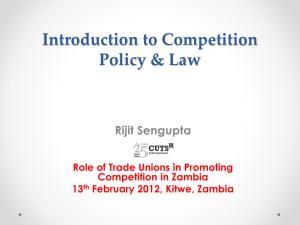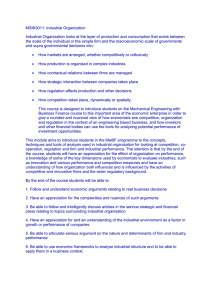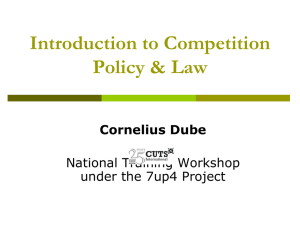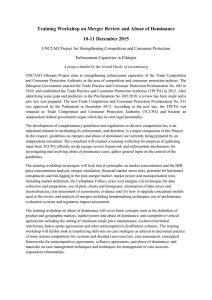Click to edit Master title style BASIC PRINCIPLES OF ECONOMICS FOR
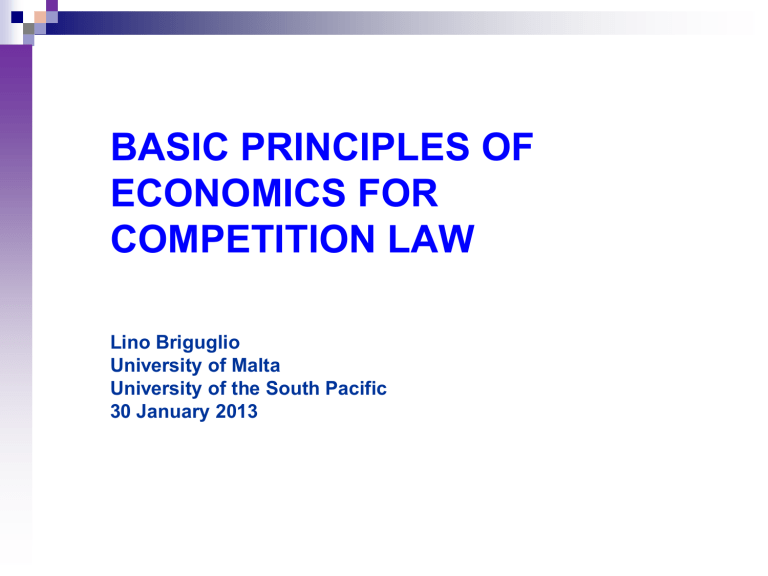
Click to edit Master title style
BASIC PRINCIPLES OF
ECONOMICS FOR
COMPETITION LAW
Lino Briguglio
University of Malta
University of the South Pacific
30 January 2013
Layout of the Presentation
1.
Mainstream Microeconomic Principles
2.
Economists and Competition Law
3.
The Need for Economic Interpretation
4.
Defining the Relevant Market
5.
Measuring Market Power
6.
Abuse of Dominance
7.
Anti-competitive Agreements
8.
Mergers
9.
State Aid
10.
Economics for Competition Law Judges
1. MAINSTREAM MICROECONOMIC PRINCIPLES
Economic principles….1
Competition as a desirable condition:
► In mainstream microeconomics, competition is considered as a desirable state of affairs.
► The model of perfect competition presents a scenario based on the assumptions of:
1.
Very intense competition and no market dominance. There are many small firms competing in the same market
2.
Perfect substitution between products . All firms sell products that are identical.
3.
Freedom of entry. There are no barriers to entry and exit from the market.
Economic principles….2
Competition and consumer welfare:
The perfect competition model is associated with maximum consumer welfare. As new firms enter the market, supply will increase and prices will go down to a point where all supernormal profits of firms (i.e. mark-up over all production costs) are eliminated. Firms at this point will be forced to produce at the lowest cost possible.
In this scenario, the consumer will benefit on two counts:
1.
firms will produce at the lowest cost possible;
2.
firms will cover all opportunity costs of production, but not more (this is what is meant by absence of supernormal profits are eliminated).
Economic principles….3
Perfect competition is unrealistic but desirable:
► Although a perfectly competitive market cannot exist in the real world, it is argued that the more a real-world market approaches perfect competition, the better it is for the consumer.
► This is because:
1.
the easier it is for consumers to find substitute goods by shopping around;
2.
the harder it is for inefficient firms to remain in the market; and
3.
the easier it is for new firms enter the market and as a result increase supply and push down prices.
.
Economic principles….4
Monopoly as an undesirable condition:
► Conversely, in mainstream microeconomics, monopoly is considered undesirable. In such a market structure, due to statutory or natural barriers to entry, the firm will be the only market provider of a product which does not have good substitutes, leaving very little options for the consumer but to buy the product at a price dictated by the monopolist.
► In the case of monopoly, theory refers to deadweight loss, where the consumer suffers on two counts, namely (1) loss of efficiency leading to high production costs and (2) monopoly pricing (ability to charge super-normal profits)
► There are however some arguments in favour of a monopolised market in that large firms are better able to reap the benefits of scale and that super-normal profit permits expenditure on research and innovation.
Economic principles….5
Imperfect competition:
► In-between these two models of market structure, mainstream microeconomics presents imperfect competition. In this case, competition exists, but it is not as intense as it is under perfect competition, either because of barriers to entry (oligopoly) or because of product differentiation (monopolistic competition).
► In both market structures, the consumer it thought to face disadvantages, arising from inefficient level of production in the case of monopolistic competition and super-normal-profit, and possibilities for collusion, in the case of oligopoly.
► Here again, consumer welfare is thought to improve as substitution possibilities increase and as entry into the market becomes easier.
Economic principles….6
Demand and supply substitutability:
These arguments lead to the conclusion that the following situations are desirable conditions for consumer welfare.
► a high degree of substitution possibilities between products, permitting the consumer to choose the better priced products;
► a high degree of freedom of entry into the market, eroding market dominance by any single firm or a small group of firms.
2. ECONOMISTS AND COMPETITION LAW
Economists and Competition Law...1
The basis of competition legislation:
► The role of economists in competition law is to a large extent related to identifying whether or not and to what extent is business behaviour anti-competitive.
► In general, economists agree that markets should be regulated, mostly (a) to avoid abuse of dominant position in a given market and (b) to prevent anti-competitive agreements and mergers that prevent or reduce competition.
► Such regulation is implemented through competition legislation, which is enacted in most countries.
Economists and Competition Law...2
The role of economists is set to grow:
► The role of economists is set to grow in cases involving competition law.
► There seems to be a movement away from per se argumentation (where an action is considered unlawful in itself, no matter what its effects) towards effects-based argumentation (where the effects of the action are considered before declaring it as being undesirablel).
► For this reason, interpretations given by economists are becoming increasingly sought after.
Economists and Competition Law...3
Economists and effects-based decision making:
► Courts in most countries of have utilised economic and econometric evidence in competition cases, and “effectsbased” decisions are becoming more common.
► Sometimes, complex theories and computational approaches are used. These are costly in terms of effort and time. Sometimes the results changed drastically with different specifications of the relationships.
► On the other hand, simple approaches are more affordable, but these may not be based on sufficient economic rigour.
Economists and Competition Law...4
Per se rules and rule of reason:
► Decisions relating to competition law can be based on per se argumentation or on the rule of reason (effects based).
► Lawyers tend to prefer working with stable and predictable rules. It is argued that court decisions should be sufficiently transparent, uniform and predictable, so that one can anticipate what actions are lawful or otherwise. For this reason, according to this argument, per se rules should be preferred to effects-based argumentation.
► The effect of business behaviour may differ depending on the type of the market. What may be anti-competitive in one circumstance, may not be so and may even be procompetitive in others. The effects-based approach often requires interpretation of business behaviour by economists so as to assess the overall ensuing effects.
3. NEED FOR ECONOMIC INTERPRETATION:
Need for Economic Interpretation…1
Interpreting the effect of a pricing strategy
► In cases relating to competition a deep analysis is sometimes needed to accompany prima facie evidence so as to assess whether a pricing strategy of a firm is pro- or anti-competitive.
► For example a situation where a firm charges low prices may be interpreted as either (a) an indication of efficiency or (b) an indicator of predatory pricing to push competitors out of the market thereby increasing market dominance.
► Here we give an example of these two possibilities
Need for Economic Interpretation…2
Strategy of low prices - predatory pricing:
► Mainstream economic theory predicts that it is irrational for a firm to remain in production if it does not cover variable costs (or avoidable costs, defined as the opposite of sunk costs). In economics, this theory is referred to as the “shut down point”
► A firm enjoying a dominant market position may be considered as engaging in predatory pricing if thefirm is dominant and if the price it charges does not cover variable
(or avoidable) costs.
► The purpose of predatory pricing is to drive competitor/s out of the market - once competition is reduced, the predator firm would then raise prices to recoup the losses.
Need for Economic Interpretation…3
Intense debate on predatory pricing
► Predatory pricing is a subject of intense debate. Low prices are often associated with a pro-competitive stance, but if the intention is eliminate rivals so as to benefit further from market dominance, low price may be considered as an abuse of dominance.
► Thus in such cases a deep analysis should accompany prima facie evidence so as to assess where a pricing strategy of a firm is pro- or anti-competitive.
► In cases relating to predatory pricing the intent to defeat a competitor so as to increase the share of the market would not be unlawful, but an intent to eliminate competitors so as to raise prices after the competitor is defeated, would be unlawful.
Need for Economic Interpretation…4
Excessive pricing and market adjustment:
► The other side of the coin relates to excessive prices. In mainstream economics it is assumed that market forces would reduce the ability of a firm to charge excessive prices, as it will be in its interests to avoid consumers switching to competitors and/or to discourage new entrants into the market.
► In mainstream economics it is argued that freedom of entry into the market and contestable markets should prevent firms from charging excessively high prices.
► Markets are therefore assumed to be self-correcting, if there is competition or if there are no barriers to entry.
Need for Economic Interpretation…5
Pricing strategies reflect various factors, including risks:
► Competition legislation often provides that when considering abuse associated with excessive pricing, the court should consider economic factors, such as the risks associated with bringing the product to the market, and the volume of purchases.
► In a small economy, the costs of importing industrial supplies or of importing consumer goods in small quantities is a major consideration in this regard.
► It is therefore not always easy to establish whether the prices charged are excessive or not, as high prices may not always be the result of absence or lack of competition.
Need for Economic Interpretation…6
Difficult to establish when a firm is overcharging:
► In practice, competition authorities and the courts may rule that firms are not overcharging, even though the price may be considered high by consumers, mostly because of the difficulty in establishing this with certainty, and also because, unlike utility regulators, the task of competition authorities is not to regulate prices.
► Competition authorities are mostly concerned with the encouragement of competition, elimination of barriers to entry.
► They generally consider excessive prices only when
► . legal or other barriers to entry are in place.
4. DEFINING THE RELEVANT MARKET
Defining a Relevant Market…1
Important role of economists:
► An important task that is often undertaken by economists of competition law relates to the definition of the relevant market.
► Such a definition is often needed in assessing behaviour of firms in the context of competition law, in (a) cases relating to abuse of dominant positions, where the focus of attention is on past practices. In this case a relatively large share of the market (for example 40%) is required for an undertaking to be investigated for abuse of dominance; (b) cases relating to mergers where the focus on attention is on the future. In the case of mergers, the objective is to to assess whether competition will be substantially reduced in the future as a result of merged firms having a larger share of the market.
Defining a Relevant Market…2
Abusers prefer a wide definition of the market:
► In general the narrower the definition of a market the easier it is to establish that a firm or group of firms have market power. As a result, firms accused of abusing of their dominance tend to prefer to define the market in which they operate as widely as possible, so as to show that their share is relatively small.
► It is not infrequent that firms accused of market abuse contest the opinion of the competition authority regarding the size of their relevant market.
Defining a Relevant Market…3
Tests relating to the relevant market:
Methods used by economists in assessing the relevant markets include:
► cross elasticity of demand
► price correlations
► the SSNIP test (Small but Significant and Non-transitory
Increase in Price).
► parallel behaviour
Defining a Relevant Market…4
Cross elasticity of demand
► The concept of the cross elasticity of demand has been used to assess the extent to which one good is a substitute for another.
► Broadly defined, this measures the relative change in demand for product X as a result in the price of product
Y, and the magnitude of the elasticity will signify the extent of substitution between the two products.
► When the two goods are independent, and therefore belong to separate markets, the cross elasticity demand will be zero.
Defining a Relevant Market…5
Misuse of elasticity estimates:
► However, this indicator can be misleading if it is used as an indicator of market power as in the case referred to as the “cellophane fallacy.”
► The flaw is that a profit-maximising monopolist will generally continue to raise price to the point where other products become close substitutes. (United States v. E.I. du Pont de Nemours & Co., 353 US 586 - 1957).
Defining a Relevant Market…6
Misuse of cross-elasticity estimates:
► One solution is to try to estimate the cross price elasticity at the competitive price rather than at the prevailing price, as the prevailing price could include a high level of monopoly profit.
► However, it is not easy to establish competitive prices as these cannot normally be observed.
Defining a Relevant Market…7
Price correlations:
► This exercise is based on the traditional economic view identical products, or products with a high degree of substitutability, will be priced equally or almost equally in a given market, or move in the same direction.
► However there are a number of problems with using price correlations. For example, there is the possibility that the prices of two products will be highly correlated even if totally different. Such spurious correlation would exist if there is a common factor leading to high level of demand for different goods.
► Finding correlation coefficient will require keeping other things constant, which in turn would have to be based on econometric analysis.
Defining a Relevant Market…8
The SSNIP test
► A commonly cited, but difficult to use, test is the socalled SSNIP test, which is an acronym for “Small but
Significant and Non-transitory Increase in Price”
► This test is intended to identify the smallest market within which a hypothetical monopolist or cartel could impose an increase in price.
► The approach is based on whether or not such a monopolist could sustain a price increase of 5 per cent for a period of time, say at least 12 months. If such a price increase is not profitable, because there are sufficiently close substitutes, then the monopolist does not have sufficient market power to raise prices.
Defining a Relevant Market…9
Parallel Behaviour
► Pricing behaviour of firms could also indicate whether they operate in the same relevant market.
► Again this approach is not fail-safe, since, as in the case of correlations, there may be other factors that may lead to parallel behaviour.
5. MEASURING MARKET POWER
Market Power…1
Tests relating to market power:
Market power is often associated with the possibility of anti- competitive behaviour.
There are three main indicators of market power:
► The Lerner Index
► Market Shares
► Concentration Indices
Tests relating to Market Power…2
The Lerner Index
► This approach is based on mainstream economics where it is argued that imperfect competition or monopoly leads to market power. This, it is argued, is related to the ability of the firm to raise price (P) above marginal cost (MC) and earn supernormal profit.
► This difference is measured as P-MC/MC and can take a value from 0 (where P=MC in a competitive market) to
1, and the more it approaches 1 the higher will be the market power of the firm.
► It can be shown that the Lerner Index is the reciprocal of the demand elasticity facing the firm when it maximizes profit.
Market Power…3
The Lerner Index
► The Lerner Index has not been used much as it is not easy to calculate in practice, given that it requires a measurement of marginal costs.
► Also the ability to increase prices above marginal cost may not be due to market power but to, amongst other things, efficiency. Thus, for example, Firm A may charge the same price as Firm B, but would earn higher supernormal profits if its per unit costs are lower.
Market Power…4
Market Shares
► Market shares are indirectly related to market power. It can be assumed that a firm will have a higher influence on the market as its share of the market increases. In many jurisdiction a market share of 40% or higher is assumed to render an undertaking as dominant.
► The problem, of course, is that when measuring market share, the relevant market has to be defined properly.
► The advantage of calculating market shares is that it may be directly related to the ability of firms to unilaterally increase in price.
Market Power…5
Concentration Indices
► The Herfindahl-Hirschman Index ("HHI) is often used in cases of horizontal mergers. The exercise involves calculating market shares of firms, squaring the shares and summing the result to arrive at a concentration index.
► The concentration levels pre- and post-merger can then be calculated to determine the competitive effects of the merger.
► The highest possible level of the HHI would be 100% squared which is 10,000. Markets can then classified as unconcentrated with an HHI below 1,000, moderately concentrated, with an HHI between 1,000 and 1,800 and highly concentrated with an HHI above 1,800.
► Again here the exercise assumes that the relevant markets can be determined
6. CONTROL OF ABUSE
OF MARKET DOMINANCE
Abuse of market dominance…1
What constitutes dominance
► Control of abuse of market dominance in a pillar of competition law. In the US this is called monopolisation.
► In the EU members states, a very large market share
(e.g. 40% share or more) leads to the presumption that the firm is dominant, - a presumption which may be rebuttable in court.
► Before an abuse of dominance is confirmed, the relevant market has to be defined in order to determine whether a firm has such a dominant position.
► The underlying assumption is that if a firm has a small share of the relevant market, the consumer will, without much difficulty, find alternative sources of supply for a given product.
Abuse of market dominance…2
Types of abuse of dominance:
► Tying. This means forcing buyers to buy a product they do not really want to buy “tied” to the product which the buyers really want. This can be considered abuse of dominance, as this restricts consumer choice and deprives competitors of selling their product. See for example Microsoft v.
Commission, (2003), which led to a fine of €497 million on
Microsoft for including its Windows Media Player with the
Microsoft Windows Operating System.
► Refusal to supply. This means that a firm withholds the sale of an essential product to a competing firm. An example was a case involving a medical company named
Commercial Solvents (Commercial Solvents Corporation v
Commission, 1974). Commercial solvents refused to supply a company named Zoja with the raw materials for a drug.
Abuse of market dominance…3
Types of abuse of market dominance:
► Charging excessive prices e.g a French funeral service was found to have demanded excessive prices, and this decision was justified on the grounds that prices of funeral services outside the region were lower
(Corinne Bodson v SA Pompes funèbres des régions libérées, 1988).
► Predatory pricing.
This means that a firm sells a product at a low price (below average variable costs) so as to eliminate rivals. In the case France Telecom SA v.
Commission, 2007). a broadband internet company was forced to pay €10.35 million for dropping its prices below its own production costs.
Abuse of market dominance…4
Types of abuse associated with market dominance:
► Price discrimination. This abuse could occur if, for example, rebates are offered on one buyer but not to another.(Irish Sugar plc v Commission of the European
Communities, 1999). In this case an undertaking enjoying a dominant position granted discriminatory price rebates to its customers, depending on whether or not those customers are in competition with it as sugar packers on the retail sugar market.
7. PROHIBITING ANTI-COMPETITIVE
AGREEMENTS
Anticompetitive agreements…1
Which agreements are prohibited:
► Another pillar of competition law is the prohibition of anticompetitive agreements
► These include agreements between undertakings, notably cartels, which have as their object or effect the prevention, restriction or distortion of competition such as:
(a) Price fixing;
(b) Limiting or controlling production, markets, technical development, or investment;
(c) Sharing markets;
(d) Applying dissimilar conditions to equivalent transactions;
(e) Make the conclusion of contracts subject to acceptance by the other parties of supplementary non-related obligations.
Anticompetitive agreements…2
Certain types of agreements may be permissible:
► Agreements or decisions prohibited are considered legally null and unenforceable.
► Fines and even imprisonment are used to deter such agreements, particularly cartels.
► Generally speaking however, agreements that improve the production or distribution of goods, or promote technical or economic progress, while allowing consumers a fair share of the resulting benefit are allowed, provided that such agreements do not impose restrictions that are not indispensable to the attainment of the agreements’ objective and that these agreements do not eliminate competition.
Anticompetitive agreements…3
Implicit and tacit agreements:
► Anti-competitive agreements can take the form of a wide array of behaviour from informal agreements during parties, verbal concurrence for collusion, adverts in the press signalling a go-ahead to increase prices, and written accords.
► Such agreements may be horizontal (e.g. between retailers) and vertical (e.g. between retailers and wholesalers).
► Generally speaking vertical agreements are considered to be less harmful the horizontal agreements.
Anticompetitive agreements…4
Case Law relating to agreements:
► There is a rich body of case-law relating to agreements.
The following are some examples:
1.
In February 2012, the French Competition Authority fined four major laundry detergent manufacturers for cartel behaviour (Unilever, Procter & Gamble,
Henkel and Colgate Palmolive)
2.
In September 2011, UK Office of Fair Trading fined supermarkets for price-fixing in the cheese industry
(Tesco)
3.
In July 2011, the European Commission fined animal feed phosphates producers for price-fixing and market-sharing (Yara Phosphates, Tessenderlo
Chemie).
8. REGULATING MERGERS AND
ACQUISITIONS
Merger Regulations …1
Mergers need clearance
► A merger or acquisition may be anti-competitive because it may lead, in the future, to the concentration of market power in the hands of fewer undertakings than before.
► In most countries there are merger regulations that oversee mergers and acquisitions before (and not after) such dealings occur, so as to prevent ex-ante abuse of market power.
► Generally speaking the law requires that firms proposing to merge gain authorization from the relevant competition authority.
Merger Regulations …2
Potential benefits of mergers
► There are benefits of mergers including the reaping of economies of scale and scope. The problem arises when undertakings take advantage of their increase in market power, so as to restrict competition to the detriment of the consumer.
► The main question that the authorities try to answer before a merger goes ahead is whether or not such a merger significantly impedes effective competition or substantially lessens competition.
Merger Regulations …3
Measuring market concentration
► Generally empirical studies by economists and lawyers are used to answer this question. Market power analysis before the merger are calculated and after the merger are predicted using indicators of market concentration such as the Herfindahl-Hirschman Index.
► In making a decision not to give the green light to a merger factors such as possible lessening of competition, increased possibilities for obscure transactions and barriers to entry of new firms are considered.
► However an increase in market power alone may not lessen competition, if it promotes efficiency through for example technical innovation in the market.
Merger Regulations …4
Failing firm argument
► In some cases, merging firms argue that a firm which is being merged is really taken over because otherwise it might fail or go insolvent. Thus a reduction of players would have occurred anyway.
► Generally speaking vertical mergers, such as an undertaking in retail business joins an undertaking in wholesale business do not pose major concerns.
► Horizontal mergers however often pose serious problems associated with the possibility of limiting the degree of competition.
Merger Regulations …5
Case law relating to mergers
► There are many cases relating to mergers. Just to mention two:
1.
In February 2012, the European Commission blocked a proposed merger of stock exchange groups, arguing that this would create a quasimonopoly in the European exchange-traded derivatives industry (NYSE Euronext / Deutsche
Börse)
2.
In March 2011, the European Court of First Instance upheld the European Commission’s decision to prohibit a merger between two airlines companies
(Ryanair/Aer Lingus, merger prohibition)
9. REDUCING THE ANTI-COMPETITIVE
EFFECTS OF GOVERNMENT INTERVENTION
AND STATE AID
State Aid and SGEI…1
Need to control inefficient state undertakings
► State Aid control is a unique characteristic of the EU competition law regime. State aid can be anti-competitive because it may give an advantage to a state undertaking vis-à-vis the private sector, or, in the case of the EU, to a particular undertaking in one member state vis-à-vis a similar undertaking in another member state.
► Generally speaking public utilities (often natural monopolies) such as railways, electricity, gas, water and media, fall under competition law similar to private companies. Often regulators are appointed as watchdogs to ensure a fair deal to consumers.
► In the EU law, state aid is generally prohibited if this is intended to support inefficient production as this is thought to distort competition.
State Aid and SGEI…2
Continuous development of state aid law
► The EU State Aid law is in the process of continuous development as there is a fine line between aiding state undertakings to unfairly compete with the private sector or foreclose potential competition, and genuinely providing a service for social purposes or a service of general economic interest.
► The EU commission has recently revised the conditions under which public service compensation can be considered compatible with the EU rules.
► In the EU if a service is declared as a service of general economic interest, it might be exempt from competition rules, under certain circumstances.
State Aid and SGEI…3
Case law relating to state aid
► A well-known case relating to general economic interest is
'Régie des RTT v. GB-Inno-BM (GB), in 1991. A small telephone equipment maker (GB), that sold phones at a lower price than those of the state telephone monopoly
(RTT) objected to the fact that the RTT did not allow GBs phones to be connected to the telephone network.
► GB argued that the special rights enjoyed by RTT under
Belgian law infringed competition law, and the case went to the European Court of Justice (ECJ). The ECJ concluded that such a restriction on competition cannot be regarded as justified by a public service of general economic interest.
► The ECJ argued that having a state service provider making phones and setting standards was anti-competitive. As a result the phone market in Belgium was opened to competition.
10. CONCLUSION
COMPETITION LAW JUDGES
NEED TO BE TRAINED IN ECONOMICS
Lawyers and Judges well-versed in Economics
► In cases relating to competition law, lawyers and economists often work hand in hand, as this branch of law requires a good knowledge of economics, mostly to understand the effects of trading behaviour. Given the need for “effects-based” considerations in competition law judgements, such collaboration is beneficial and essential.
► However, sometimes, judges of cases involving competition issues are not well versed in economic theory. This often happens when there are no specialised tribunals considering appeals decisions taken by the competition commission.
► It is therefore useful to have special tribunals considering appeals from decisions taken by the Competition
Commission or to offer training to judges in competition law.
